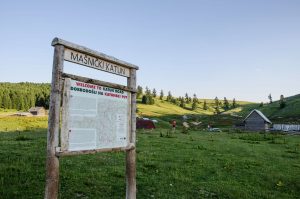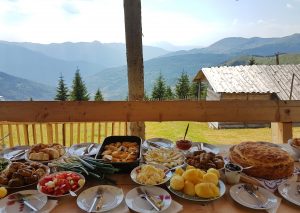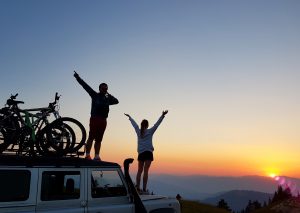Interview by ATTA member and AdventureEDU Educator Kirsi Hyvaerinen, PRÁTTO Consulting, Montenegro

The 2018 summer season is fast approaching and we spoke with the Director of the Regional Development Agency Bjelasica, Komovi and Prokletije of Montenegro, Jelena Krivcevic, about her experience regarding how to make community-based tourism happen in a challenging environment.
Q: Jelena, so far, the only Regional Development Agency in Montenegro began work eight years ago. You moved from the fast-growing capital city of Podgorica to your roots in the backcountry town of Berane in the North. In the municipalities of your region, the unemployment rates are among the highest in the country (three out of five citizens were unemployed 2014, see: www.mojgrad.me). Migration and ecological problems add to the basic picture of a hopeless situation. What were your motivators to start here and what role has adventure tourism development played in your projects so far?
A: I was born and raised in this part of the country. After having worked for 5 years in international development, and with EU integration related reforms happening in Montenegro, I thought it was time to return home and work in my communities. It is completely different working at home than internationally. Every success here is far more fulfilling, and every failure or mere obstacle far more frustrating. But this is my dream job, despite the numerous challenges and difficulties.
What I love about this ‘backcountry’ is its ‘backcountrishness’. Few places in the developed world have what we have here. Basically, you don’t need a car for daily errands. Grocery shopping here is probably a dream come true for the western world. The green market is actually an organic food market, and you get to meet all the producers. If you want to get active, you can do so without any complicated or expensive logistics. Just a kilometer (0,6 miles) away, you are in the mountains. Spend three days here, and on the fourth day, people on the road will be greeting you as if they knew you forever. Hospitality in our rural communities is not learned by a book or at fancy courses. It is not professionally polished and polite, but part of a long tradition of our people. I have witnessed many guests from abroad being completely charmed by the hospitality of our locals. We have had some hard time convincing rural families, although they have serious economic challenges, that they simply must charge their guests for food and beverages; that is how generous their hospitality goes.
Furthermore, this part of Montenegro is the wild ingredient of the Montenegrin ‘Wild Beauty’ slogan. I was unable to see this beauty before I came to live amidst it. But as soon as I was away, I gained certain objectivity and could see clearly and with comparison. We live in a truly spectacular area. And this is where we, in our organization, always find inspiration for project ideas that we develop, and if lucky enough, implement. Our job is to be out in the field and learn from people about their living conditions, problems and opportunities. We translate what we learn into proposals – bottom up.
Recently, I was told that our projects are unique for being very tangible and to the point. That is because of this continuous field exposure. So, once we have been able to understand our communities from every angle, we recognize that adventure travel could become one of the main gateways for development of this region. We have made many mistakes and have learned from them, and I´m sure we will continue to learn new things in the future.
Q: One of the latest cross-border innovations has been the “Katun roads” between Montenegro and Kosovo. What are katuns, what is the idea behind the project and why is it special?

A: Katuns are probably the most significant cultural heritage of the rural Balkans, Montenegro in particular. People in the mountains have lived through centuries of cattle breeding and their whole life revolved around the needs of the cattle. One of the major needs is how to feed the animals when green land parcels in the valleys are scarce. The tradition of moving higher onto the mountains in summer, as soon as snow melts, was born from the need to provide food and water for the animals. Katuns are temporary settlements that were set up in the mountains with specific, simple architecture, cooking, and a way of life. This tradition, although in constant decline, is still practiced in Montenegro and Kosovo.
We mainly wanted to do two things: On the one hand, to help improve living conditions for the farmers in katuns. For example, providing them with mobile solar systems, as they are not connected on electrical grids. On the other hand, we wanted to let visitors experience the beauty of the mountains, the idyllic ambiance of the katuns, with the perfect synergy of man and nature, old-time traditions and the ability to reflect on everything around you. And by doing so, help preserve this traditional way of life by introducing new income opportunities for the families. Actually, katuns are so special that I am still stunned they are so marginalized and neglected - I simply cannot believe they are not the central part of our mountainous tourism offer yet!
Q: What activities, within this project, have made a difference to the locals? And for future adventure travelers?
A: We have worked with 50 families. The solar systems they have received are an enormous improvement in their quality of life – none had electricity. Also, we have educated them on rural tourism, how to offer services, on food safety measures, etc. For travelers, there is appropriate signposting along the trail. Five wilderness camping sites are set up at five katuns and there are further resting points as well. On the dedicated website, katuns are presented as cultural heritage; this particular trail and services are explained; a video promotion of the katuns and their people; and in the multimedia section, brochures and a biodiversity map can be downloaded.
Q: What have been the biggest challenges to make all this happen? Any key advice to other community-based tourism developers?
A: You must adjust to the farmers and local realities. You cannot replicate something that worked well elsewhere and expect it to work the same way in any given community, it simply does not happen that way. You need to know the community to know what can work, and what will never work. Our team has spent two summers at the katuns, living and working with the locals. We will continue to maintain contact with them in the coming years.
Another thing, when you work with beginners, you cannot expect that after you have provided infrastructure assistance and a couple of trainings that things will launch successfully. A lot of hand-holding is still necessary. Continuous mentoring means that you have to stay in touch and help overcome unexpected obstacles. And, of course, you must know when to let go. Recognizing that momentum is very important and staying prepared for disappointments too, because they will surely happen. You need to learn your lesson, move on and get the most out of it without losing drive. That is a tough one!
Q: You mentioned mistakes and lessons learned – please, give us an idea of your “Top 3.”
A: There are many of them and all part of our learning process. I will focus on those made by us and by others, things that are relevant for the growth of the adventure travel industry. One we used to make in the beginning, was related to developing trails. We were so focused on all the technicalities relevant for trails, that we forgot the people, businesses and culture presented alongside the trails. It is imperative for the overall quality, the “look & feel” of the trail and the sustainability to include local actors, promote them together with the trail, and help bring business to them. Then their response leads to the “win-win” we aim for.
The second one is about overregulating simple things and forgetting local mentality in the process. For example, in Montenegro we have a really good, Austrian-alpine style regulation for mountain trails. But Austrians only visit – they don’t live here. Although everything on paper and in theory looks perfect, a lot of signalization has been devastated, due to poor maintenance and the generally low awareness of the local population on the importance of those trails.
The third and most important one: it is all about people! The lousiest ideas will work fine with active, dedicated, responsible people, while the best ideas in the world will fail if realized with lousy people. It doesn’t matter how bullet-proof an idea sounds, it will fail if it is placed in the wrong hands. Conclusion: When trying something new, developing offers, services, whatever, find the right people for it first. And finding the right people is an art form learned only by meeting people, failing with them, and trying again!
Q: Practically speaking: How long does the full katun trail take to hike? What accommodation capacities are available? When is the best time to visit and how should a tour be arranged? How about biking it?

A: This trail is a thematic one, dedicated to the katuns, and can be taken in many ways. You can hike or bike it, or if you are not that adventurous or fit, you can visit with an off-road vehicle. You can also choose sections instead of the full trail. It is designed to suit many types of travelers. Therefore, it can take five days or just one - we warmly recommend the extended experience and time spent at the katuns.
On the www.katunroads.me website you can find various options for accommodations. At the lower parts of the mountains there are small hotels; at the katuns there are wilderness camps, and also some cottages near the katuns that owners are willing to rent. You can explore and connect with other trails in the vicinity of the “Katun road”. Currently, for the best information, please visit www.pedalaj.me. Talking about the right kind of people, this portal is the work of a single local enthusiast, a great source of information for any adventure traveler.
Q: What is it that keeps you going?
A: I plan to stay here as long as possible and do my best in making even tiny differences, just to show that they can be made. I have this terrible feeling that no one knows how to meaningfully help this region, to stabilize the economic situation and to stop migration. Migrations are normal, and I understand them. But we suffer from huge brain drain, resulting in the situation where we really lack capacities, particularly in places that should be driving the sustainable development of this area. That is scary for all of us who live here.
However, what keeps me going are those tiny differences that we make with our work, as well as the rural people who survive from their own work close to nature. They have the most realistic picture of everything because they live a life that is based on reality. Therefore, making small improvements in their communities is what makes us proud, happy and motivated.
Q: How about your future plans in this area?
A: We will keep doing this work in the future, although we do not have stable sources of funding, but depend on project-based funding. That is why, from time to time, we must apply for projects that are not in the core of what we want to do, but funding dictates the name of the game. This is a real pity for our organization and stakeholders. If we could focus on what we do best and what is needed the most, the results would be much better.
But, as always, we have a couple of projects that we are very excited about. In 2018-2019, we will implement two projects we really like. One is dedicated to local gastronomy and traditional food products, and the other is focused on cultural landscaping, traditional architecture and how to prevent people from building houses that do not fit into the landscape, in particular, the attractive and vulnerable nature zones. We will keep paying special attention to the katuns in both projects. What we do continuously and voluntarily, even with zero funding and in our own time, is motivating new rural families to get engaged in sustainable tourism.
